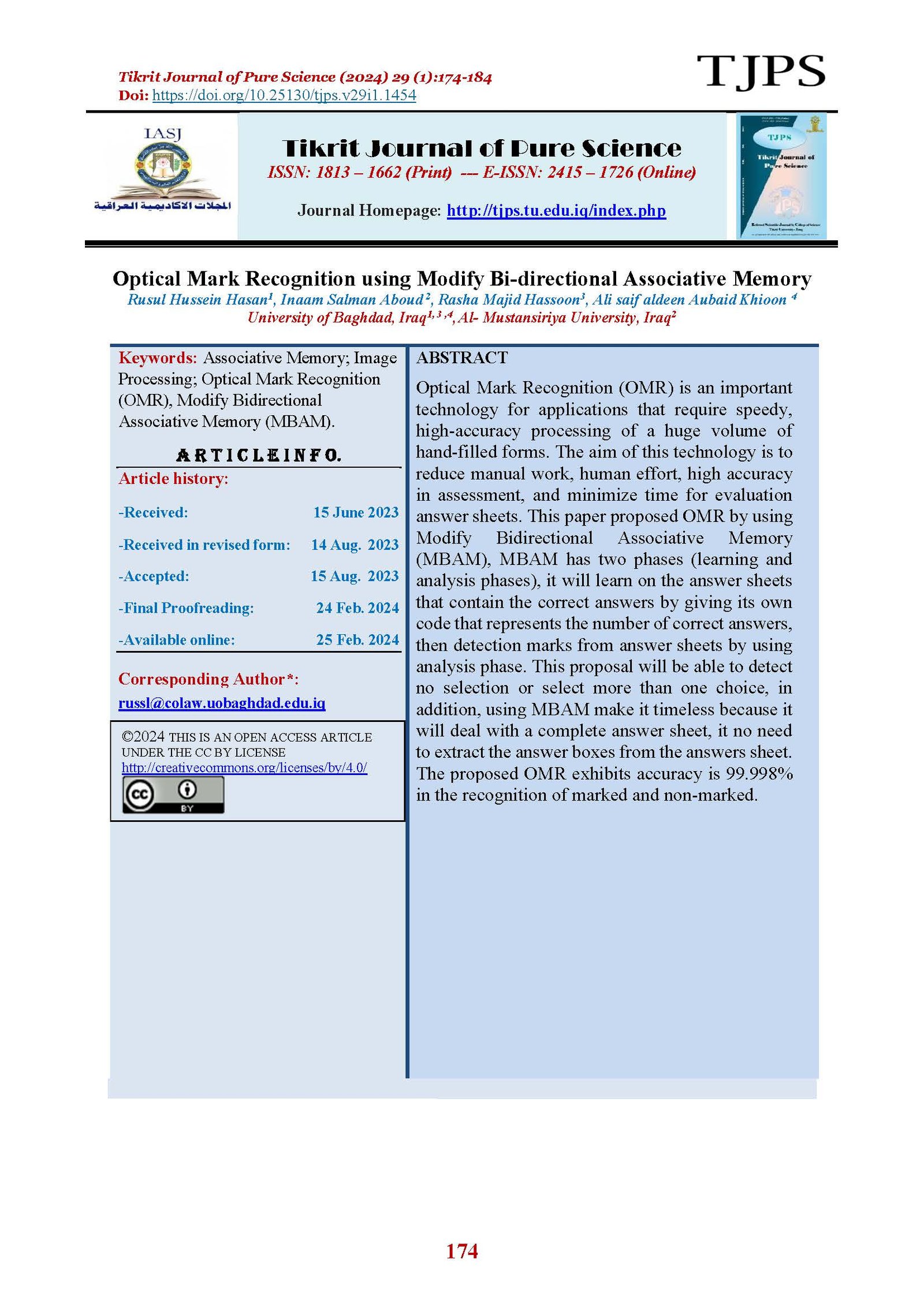Optical Mark Recognition using Modify Bi-directional Associative Memory
Main Article Content
Abstract
Optical Mark Recognition (OMR) is an important technology for applications that require speedy, high-accuracy processing of a huge volume of hand-filled forms. The aim of this technology is to reduce manual work, human effort, high accuracy in assessment, and minimize time for evaluation answer sheets. This paper proposed OMR by using Modify Bidirectional Associative Memory (MBAM), MBAM has two phases (learning and analysis phases), it will learn on the answer sheets that contain the correct answers by giving its own code that represents the number of correct answers, then detection marks from answer sheets by using analysis phase. This proposal will be able to detect no selection or select more than one choice, in addition, using MBAM make it timeless because it will deal with a complete answer sheet, it no need to extract the answer boxes from the answers sheet. The proposed OMR exhibits accuracy is 99.998% in the recognition of marked and non-marked.
Article Details

This work is licensed under a Creative Commons Attribution 4.0 International License.
Tikrit Journal of Pure Science is licensed under the Creative Commons Attribution 4.0 International License, which allows users to copy, create extracts, abstracts, and new works from the article, alter and revise the article, and make commercial use of the article (including reuse and/or resale of the article by commercial entities), provided the user gives appropriate credit (with a link to the formal publication through the relevant DOI), provides a link to the license, indicates if changes were made, and the licensor is not represented as endorsing the use made of the work. The authors hold the copyright for their published work on the Tikrit J. Pure Sci. website, while Tikrit J. Pure Sci. is responsible for appreciate citation of their work, which is released under CC-BY-4.0, enabling the unrestricted use, distribution, and reproduction of an article in any medium, provided that the original work is properly cited.
References
1- Ms.Sumitra B. Gaikwad, (2015) "Image Processing Based OMR Sheet Scanning", International Journal of Advanced Research in Electronics and Communication Engineering (IJARECE) Volume 4, Issue 3.
2- Arica, N. ve Yarman-Vural, F. T. (2001) An overview of character recognition focused on off-line handwriting. IEEE Transactions on Systems, Man, and Cybernetics, 31(2), 216-233.
3- Stephen Hussmann, Leona Chan, C. Fung, M. (2003), Albrecht, "Low Cost and high speed Optical mark reader based on Intelligent line Camera", Proceedings of the SPIE AeroSense 2003, optical pattern recognition XIV, Orlando, Florida, USA, vol. 5106, p. 200–08.
4- Getinet Amare Mekonen, (2019) Scanned Image and Web Based OMR for Ethiopian National Examination, A Thesis Summited to the Graduate School of Applied Sciences of Near East University.
5- Loke SC, Kasmiran KA, Haron SA (2018) A new method of mark detection for softwarebased optical mark recognition. PLoS ONE 13(11): e0206420.
6- Nisreen Abd Alhadi Jabrand Emad I Abdul Kareem (2015), "Modify Bidirectional Associative Memory (MBAM)", International Journal of Modern Trends in Engineering and Research (IJMTER) Volume 02, Issue 08, ISSN (Online):2349–9745; ISSN (Print):2393-8161.
7- Jabr,N, and Kareem, (2016) E, Novel Hetero-Associative Memory: A Modified Bidirectional Associative Memory. Int J Eng Res Adv Technol, Volume 02, Issue 02; ISSN (Online): 2454-6135.
8- Rusul Hussein Hasan, Emad I Abdul Kareem., (2015)"An image processing oriented optical mark reader based on modify multi-connect architecture mmca." International Journal of Modern Trends in Engineering and Research (IJMTER) 2.7: 414-423.
9- Emad I., Wafaa A.H, and Aman J, (2012), Multi-Connect Architecture (MCA) Associative Memory: A Modified Hopfield Neural Network, Intelligent Automation & Soft Computing, and 18:3, 279-296, https://DOI: 10.1080/10798587.2008.10643243.
10- Rusul Hussein Hasan, Emad I AbdulKareem, (2017) "Modify Multi-Connect Architecture (MMCA) associative memory",Conference of the Mathematics and Computer Departments, Al Mustansiriyah University, Vol2.
11- Seng Cheong LokeID, (2018), A new method of mark detection for software-based optical mark recognition, University of Braunschweig - Institute of Technology, GERMANY.
12- Amit Kumar, Himanshu Singal, Arnav Bhavsar, (2018), Cost Effective Real-Time Image Processing Based Optical Mark Reader, World Academy of Science, Engineering and Technology International Journal of Computer and Information Engineering Vol:12, No:9.
13- Afifi, M., Hussain, K.F. (2019), the achievement of higher flexibility in multiple-choice-based tests using image classification techniques. IJDAR 22, 127–142. https://doi.org/10.1007/s10032-019-00322-3.
14- Pooja Raundale and etal, (2019), Optical Mark Recognition using Open CV, International Journal of Computer Applications (0975 – 8887) Volume 178 – No. 37.
15- Asmaeil Ammarah Abdullah BALQ, (2019), OPTICAL SIGNAL RECOGNITION SYSTEM USING IMAGE PROCESSING TECHNIQUES, Kastamonu University Institute of Science and Technology Department of Genetic and Bioengineering.
16- Mondal, S., De, P., Malakar, S. et al., (2023) OMRNet: A lightweight deep learning model for optical mark recognition. Multimed Tools Appl. https://doi.org/10.1007/s11042-023-15408-8
17- Kanjalkar, P., and et al., (2023). Economical Solution to Automatic Evaluation of an OMR Sheet Using Image Processing. In: Sharma, N., Goje, A., Chakrabarti, A., Bruckstein, A.M. (eds) Data Management, Analytics and Innovation. ICDMAI 2023. Lecture Notes in Networks and Systems, vol 662. Springer, Singapore. https://doi.org/10.1007/978-981-99-1414-2_48
18- Rafael C. Gonzalez and Richard E. Woods,(202) “Digital Image Processing”, second Edition, Prentice Hall
